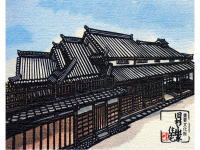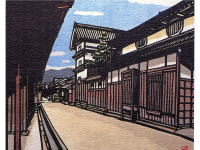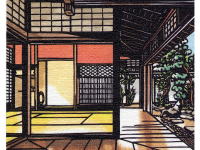富田林寺内町の探訪
I'm glad to intorduce an old town, Jinaimachi, Tondabayashi, Osaka, Japan as a national historic district and heritage site.
It takes 30 minutes from Osaka city to Tondabayashi station by Kintetsu railways. A 10-minutes walk will take you to the historic town.
ギャラリー
welcome to jinaimachi town, tondabayashi, a historic district, japan
| 【Tourist guide to Jinaimachi town, Tondabayashi, a historic district and heritage site of Japan,Tourists attractions part 1/2】 | ||||
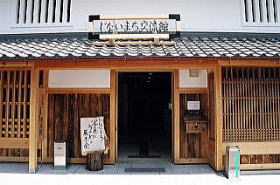 Jinaimachi Visitor Center (Tomiyama-cho) |
Let's take a walk around the historic district of Tondabayashi Jinaimachi.
Would you enjoy walking from Jinaimachi Visitor Center to the former Sugiyama
residence along Jyounomonsuji street?(in about 90 minutes) This is a quick guide of toursits' attractions. |
|||
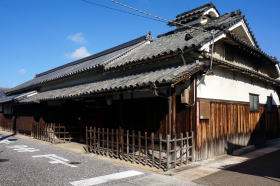 the head of the Okutani family residence (Tomiyama-cho) |
1.In front of the head of the Okutani family residence In the Edo era or in the middle 18th century, the family comes out from Kawachi-Nagano to Tondabayashi. The family flourished in trading timber business. 2) The round tiles and corrugated tiles are alternately arranged.(hongawara-buki style) 3) The pattern of the face of the round tiles is called "tomoemon", which represents the vortex of water. People were mindful of prevention of fire. |
|||
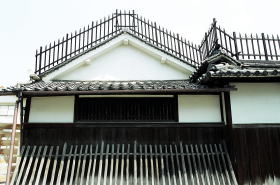 Shinobigaeshi |
||||
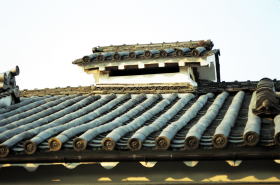 The roof of traditional house is characterized by kemuridashi and hongawara buki style |
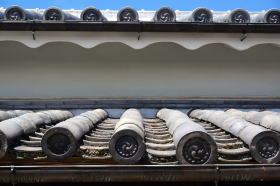 round roof tile with tomoemon design pattern |
|||
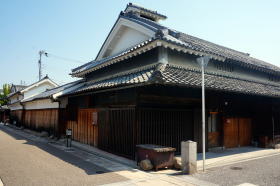 the east Okutani family residence (Tomiyama-cho) |
2. In front of the east Okutani family residence As seen in traditional townhouses in Kyoto, the height of second floor is lower, which is a storeroom, as it was not a living space. In the Edo era, there existed a hierarchy system and hierarchy of samurai warriors was classified as the highest rank. Therefore, merchants were not supposed to overlook from the second floor, while samurai warriors pass by. A fire protection water tank has been placed. |
|||
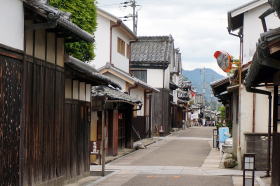 Jyounomon-suji street |
3. On Jyounomon-suji street There remains a fire ditch called "youjin-bori". |
|||
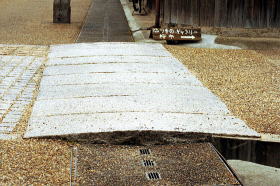 "youjin-bori" |
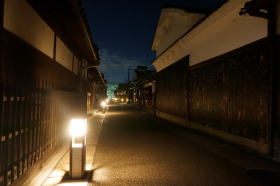 The street is lighted up in the night |
|||
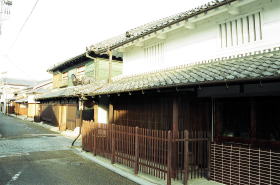 |
4. At the intersection of Ichiriyama-cho street and Jyounomon-suji street The height of second floor of the three residences is compared and chronological order can be easily found, such as the Shibuya’s residence, then across the street, the Oda’s residence and the Abe’s residence. The Shibuya’s residence with copper wall of green rust is the newest among the three, which is a modern building of the Taisho era. The family had run a furniture retail store until around the end of the Showa era. The Oda’s residence was built in the Meiji era, and the Abe’s residence was built in the Edo era in turn. |
|||
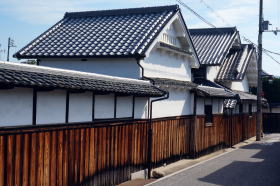 the south Okutani family residence (Kita Kaisho-cho) |
5. At the south corner of the (south) Okutani family residence For landscape conservation, the gas meter device is placed inside the fence so that you can measure it from the small window. Viewing from here toward the east: You can find the intersection had deliberately poor visibility as it is referred to as a "hit and bent intersection" or “ atemage-no-tsuji”. It was designed to interfere with the enemy of the intrusion during the Warring States Period when Jinaimachi town was built. It is now called a "hit-and-run road" as a car is hard to go. |
|||
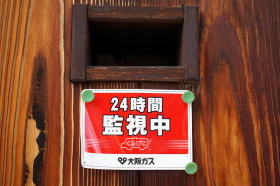 For landscape conservation |
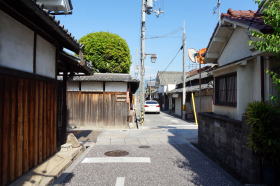 “ atemage-no-tsuji”(Kita Kaisho-cho) |
|||
| 6. The Sato family residence (Café Heizo in Koubai-Kura) The Sato family used to run brewing of "red plum mirin seasoning". |
 The large pot has been left in the coffee shop as it has been buried in the ground. |
|||
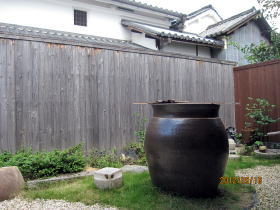 Koubai-Kura(Kita Kaisho-cho) |
||||
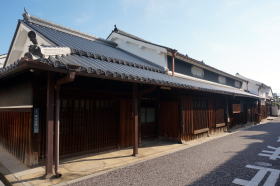 The Kuzuhara family residence (Minami Kaisho-cho) |
7. The Kuzuhara family residence The Kuzuhara family flourished in the brewing industry. They did business as "Totsukawa-ya". They began the brewing industry after they came out of Totsukawa village in Nara prefecture. At the time, they produced a liquor brand of "Tenkaichi Masamune". After the war, they have been out of the business while tools and instruments still remain in the house. Latticed window with parent and child grid: By thinning out the top of the grid, people can see outdoors from the room of the building. |
|||
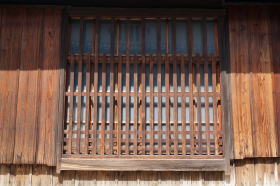 Latticed window with parent and child grid |
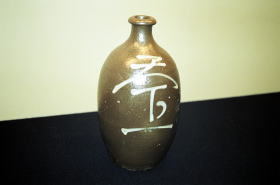 branded as "Tenkaichi Masamune" |
|||
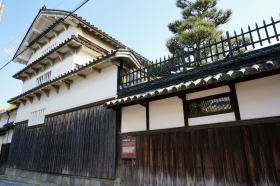 The (south) Kuzuhara family residence |
8. The (south) Kuzuhara family residence Degoushi mado (a kind of latticed window) The style is used in the traditional buildings such as Buddhist temples or Shinto shrines like Kasuga Grand Shrine in Nara. When you look through the window while walking, the scenery through the window look like moving as the principle of animation pictures. Fine ridge-end tile and sharpened wood fence called shinobigaeshi for security devices Sankai-kura (three story storehouse): This storehouse is the landmark in Jinaimachi which was used for |
|||
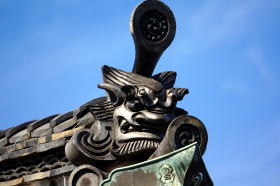 Fine ridge-end tile called Onigawara |
||||
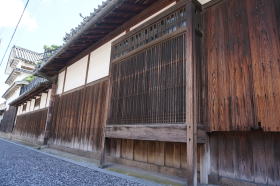 Degoushi mado (a kind of latticed window) |
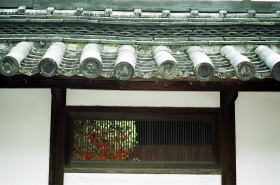 Renji mado (a kind of latticed window) |
|||
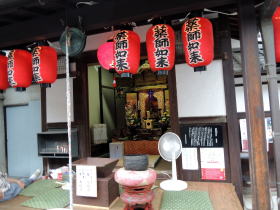 Yakushido |
9. Yakushido The Buddha of Healing (Yakushi Nyorai)is laid in the small pavilion away from the precinct of Jyokokuji Buddhist Temple. It is a seated statue made of dry lacquer. It is friendly called as Koibumi Yakushi or Buhhda of Love Letters. According to the ancient folklore, many love letters of young men and women of the believers were laid up one after another inside the Buddha statue, which were plastered by lacquer and then gold leaf was finally coated on the surface. |
|||
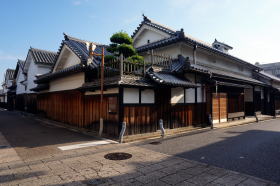 the Tamori family residence |
10. The Tamori family residence The Tamori family used to be a wholesaler of cotton produced in Kawachi region, doing business as Kuroyama-ya as they came from Kuroyama in Mihara to Tondabayashi. Along Jyounomon-suji street, the warehouses of the Tamori family residence are located including, from the north to the south in turn, cotton storehouse, rice granary and costume warehouse. At the lower part of the wall of the cotton warehouse, the exterior wooden panels of the wall used in cotton warehouse are called Yaki-ita made of Japanese cedar. Yaki-ita literally means burnt-plate whose surface is carbonalized for the durability. The roof-style of the rice granary is called Oki-Yane, which looks like being just put on the building structure with some space for air ventilation to make the heat inside discharged. |
|||
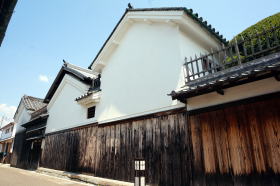 the Tamori family residence |
||||
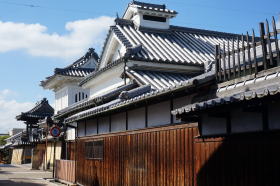 the Sugita family residence |
11. At the Sugita family residence and the Tamori family residence located across Jyounomon-suji street |
|||
| On the wall of the side of the roof, a ceramic doll of Shoki-san has been placed. I will tell you a legend on Shoki-san. When Emperor Xuanzong(玄宗皇帝)in the Tang Dynasty was sick, a demon appeared in his dream and the demon
was trying to steal the treasure of Emperor Xuanzong and Empress Yang Guifei(楊貴妃), Shoki-san appeared, quickly drove away the demon. And then Emperor Xuanzong
was healed from disease. Shoki-san is a legendary and imaginary person. Let me tell you another episode on Shoki-san. A long time ago, there was a drug wholesaler in Sanjyo, Kyoto. The young daughter of the drugstore had got in bed with a long illness some time. Since the family business is drugstore, the parents gave her a variety of drugs, but not at all well. The parents noticed that a large house had been newly built up to the opposite of their own home and on the roof of the new house, the ridge-end tile with demon face was put towards their house, the parents put the tile doll of Shoki-san towards the demon. The daughter is said to have healed from the disease immediately. There certainly exists a demon (ridge-end tile) of the Tamori family residence on the opposite of the Sugita family residence, and on the contrary, there also exists a Shoki's tile doll of the Tamori family towards a demon (ridge-end tile) of the Sugita family each other. |
||||
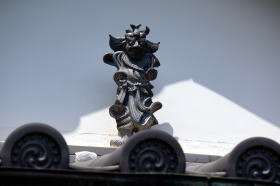 the Sugita family residence Shoki-san |
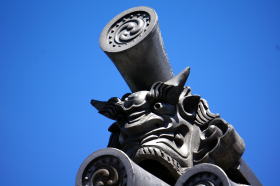 the Tamori family residence ridge-end tile |
|||
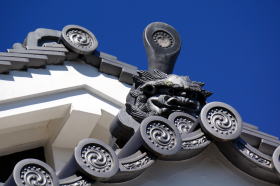 the Sugita family residence ridge-end tile |
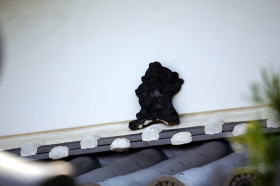 the Tamori family residence Shoki-san |
|||
| 【Tourist guide to Jinaimachi town, Tondabayashi, a historic district and heritage site of Japan,Tourists attractions part 2/2】 | ||||
|
||||
| |
||||
Information
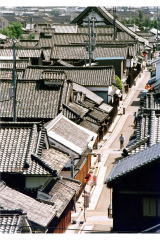
Jinaimachi in Tondabayashi(Jyounomon-suji street)
Photo: provided by Tondabayashi Municipality, unauthorized copying and
replication are strictly prohibited.
National conservation district of valuable traditional buildings
Jinaimachi town, a part of Tondabayashi-cho located in Tonadabayashi city
has been chosen as a national conservation district of valuable traditional
buildings since 1997, which is only selected in Osaka Prefecture. Among
approximately 500 buildings in the town, 181 buildings built during the
period from the Edo era to the early Showa era have been identified as
traditional buildings.
An application for prior approval to the section of cultural properties
in board of education of Tondabayashi city is required when any change
of current exterior appearances viewed from a street in the conservation
district such as enlargement, renovation, repair, redecoration, change
of the color, new construction and demolition of any buildings is to be
made. After repairing works for the conservation of the exterior appearances,
the reconstruction and face-lifting in consideration of landscaping, a
white wall, a board fence, and a lattice door of traditional house remain
as used to be, and rustic and calm atmosphere has been kept as people still
live in those houses.
The signpost is provided with main traditional residences to explain each
origin and history, and those guiding signposts cum street lights have
been placed along the streets of stone-pavement.
In addition, the appearances of newly built buildings are also harmonized
with the neighboring historic district in consideration for the traditional
townscape in Jinaimachi town.
Location
Jinaimachi town, Tondabayashi city, a national historic preservation district
and heritage site of Japan, which is located in the south-eastern part
of Osaka prefecture, the western part of Japan
Directions to Jinaimachi town, Tondabayashi
It is a 10-minute walk from Tondabayashi Staion or the Tondabayashi Nishiguchi Station of Kintetsu Nagano line.
From Kansai International Airport
Airport Limousine Bus service available bound for Kawachi Nagano Station.
(60 minutes) Please take Kintetsu railways from Kawachi Nagano to Tondabayashi.(15
minutes)
From Osaka International Airport (Itami Airport)
Airport Limousine Bus service available bound for Abenobashi Station. (30
minutes) Please take Kintetsu railways from Abenobashi terminal to Tondabayashi.(30 munites)
From JR Shinkasen Shin-Osaka station or
Osaka (Umeda) station
Please take Subway Midousuji line from Shin-Osaka station or Osaka (Umeda)
station to Tennoji Station. (20~30 minutes) Please change trains at Tennoji
and take Kintetsu railways from Abenobashi terminal to Tondabayashi. (30
minutes)
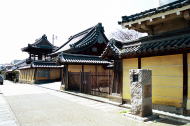
Koushouji Betsuin Temple (Tondabayashi Gobo)
Koushouji Betsuin Temple is a temple of Jodo Shinshu School (Ikkoushuu School),
which became the center of the development and establishment of Jinaimachi
town in Tondabayashi . It has been popular as Mr. Gobo (Tondabayashi Gobo)
among the local residents.
During the Ouei period (1394-1412years) , the
The temple gate looks toward the east and the Jyounomon-suji street. Those buildings such as the bell tower, the drum tower, the main hall,
the reception hall and priest's quarters are set up and arranged.
The main gate has refined style and it became clear in a recent investigation
that the gate was further relocated from Koushouji temple in Kyoto, which
was originally said to be dismantled and reconstructed from one of the
gates at Fushimi castle in Kyoto.
Koushouji Betsuin Temple was designated as an important cultural property
of the country in 2014.
The site-seeing map available in English
Please stop by to the Tourist Information Cetnter or Jinaimachi Visitor Center.
Restrooms
Available at Jinaimachi Visitor Center (Jinaimachi Kouryuukan), Jinaimachi Center and Jinaimachi Tenbou Hiroba (Viewing Terrace)
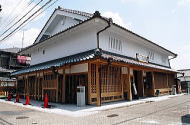
Visitor Center
(Jinaimachi Kouryuukan,
Town Community Center)
Address
9-29, Tondabayashi-cho, Tondabayashi city, Osaka, 584-0033, Japan
TEL.+81-(0)721-26-0110
FAX.+81-(0)721-26-0110
open 10a.m. until 5 p.m.
closed on Monday
Visitor Parking
Road width is very narrow in Jinaimachi town. If traveling by car, please
use Tondabayashi Municipal east parking newly opened in February 2014 (Toll
parking).
You can park the minibus for groups and passenger cars for general use.
Only one parking lot available for minibus, you must book it in advance
with Tondabayashi City Hall. A 15-minute walk to the Jinaimachi Visitor
Center and 5 minute walk up to the former Sugiyama family house, an important
national cultural property.
You will note that you will contact Tondabayashi Municipality Office for
a parking lot of large tourist bus for groups. Thank you in advance for
your kind cooperation.
